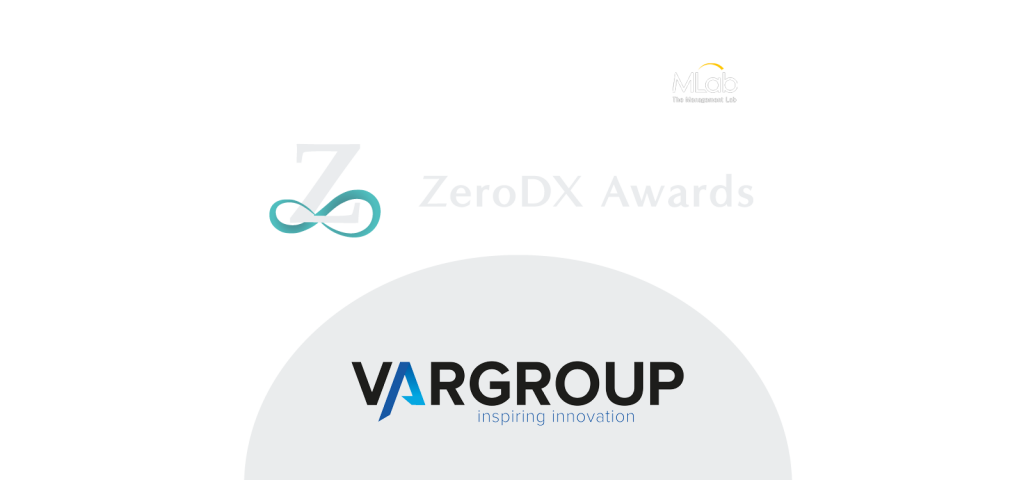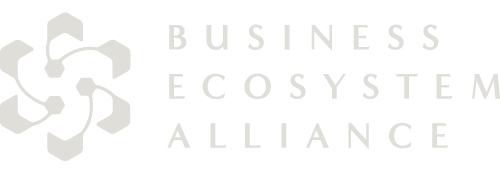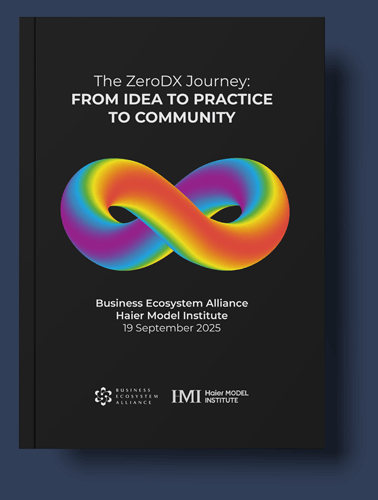
VAR GROUP
By Emanuele Quintarelli, RenDanHeYi Open Source Research Center
VAR Group is a 50+ year-old international system integrator that supports companies in their digital evolution and develops business models to enhance their excellence worldwide. It has over 3850 employees operating across 13 countries, including China and the USA, and a turnover exceeding 820M Euros with the ambition to exceed 1B in the coming years.
It is part of SeSa SPA, a leading provider of technological innovation and digital solutions for the business segment, with consolidated revenues of over 3B Euros. With growth exceeding 10% in comparison to 2023, SeSa S.p.A. is listed on the Euronext STAR market in Milan and pursues a strategy of sustainable development to benefit its stakeholders through strong human expertise and a clear emphasis on environmental and social responsibility.
BUSINESS DRIVERS
In the initial phase of VAR Group's evolutionary design work to support its portfolio and growth strategy for the coming years, an explicit connection between business priorities and organizational design aspects was articulated to ensure optimal alignment between ambitions for the future and the social, cultural, and process dynamics underlying the group's way of working.
In addition to fostering organic business development, VAR Group historically invested in strategic mergers and acquisitions, targeting other players with vertical expertise in the same or adjacent markets. Playing this game guaranteed up-to-date competencies and sustainable, double-digit growth in a highly dynamic and competitive environment.
Due to the relentless integration of other businesses, VAR Group can be better imagined as a diversified constellation of multiple entities, cultures, systems, and teams under a common brand and governance than a traditional monolithic corporation optimized for scalable efficiency and centralized control. Protecting its energy, autonomy, and optionality DNA while accelerating a compelling, credible, and well-orchestrated trajectory of further penetration in Italy and abroad was the central challenge that got VAR Group interested in platform organizations and Haier's RenDanHeYi model.
More specifically, the group's leadership team, partly composed of the former owners / managing directors of the acquired businesses, was searching for solutions that could help materialize the following benefits:
- Protecting and further fostering the entrepreneurial drive and identities that allowed the original legal entities (now business units in VAR Group) to bring excellent services, customer experience, and value to their markets.
- Enabling a smooth, scalable, modular, and synergic integration and composition of all the capabilities offered by the business units in the Group.
- Balancing business units' priorities and incentives with VAR Group's overall goals, growth and brand equity.
- Making it easier for clients to perceive, understand, and consume the most appropriate subset of VAR Group's growing and sometimes confusing portfolio of offerings.
- Developing internal cooperation mechanisms through which business units could collaborate and support each other.
- Maintaining a complete, coherent, and up-to-date picture of what business units offer, considering the opportunity to resolve excessive overlaps or duplication.
- Timely collecting and acting on market trends to refresh the service portfolio.
- Continuing the journey of power distribution from senior management to the business units regarding strategy, commercial initiatives, investments, and operations.
- Having time and cost-effective ways to participatively adhere to policies with impacts cutting across all the business units.
HOW THE RENDANHEYI COULD HELP
Rethinking VAR GROUP's organizational design and go-to-market as a platform of integrated services and solutions seemed the best approach for achieving desired levels of quality, flexibility, innovation, and coherence.
Haier's RenDanHeYi offered solid inspiration and reference for how to:
- Increase VAR Group's Business Units speed, effectiveness and competitiveness in addressing market demand and changes.
- Reduce internal attrition and facilitate internal collaboration across Business Units.
- Improve work climate and satisfaction by allowing for broader individual and team initiative.
- Raise profitability by aligning multiple Business Units' interests around common customer outcomes and within a clear set of common rules.
- Smash organizational debt and bureaucracy by letting external players to put pressure on internal services and support functions.
- Create group-wide investment and incubation paths for new promising ideas.
- Clarify professional development career paths within and across Business Units.
- Understand which services should have been centralized to guarantee consistency, quality and economy of scale.
- Reimagine go-to-market mixing commercial autonomy in the specific territory or client with overall group-level coherence in sales conversations.
- Establish a common organizational taxonomy in terms of how teams should be formed, function, evolve and work together
- Consider VAR Group especially as the enabling framework for multiple businesses to be acquired / created, incubated, accelerated and integrated.
WHAT THEY DID
VAR Group's transformation towards becoming a platform organization started in the second half of 2023 and went through a process of gradual involvement of larger portions of the organization into new concepts and practices inspired to Haier's RenDanHeYi and Boundaryless's frameworks such as the 3EO (Entrepreneurial Ecosystem Enabling) Toolkit and the Platform Design Toolkit.
Coming already from a largely distributed, entrepreneurial and flat organizational design achieved through numerous mergers and acquisitions, the project team worked together along the following phases and steps.
A Setup Phase got the initiative started through:
- An Etnographic Mapping of the business context, the initial organizational state, current decision making and power allocation mechanisms.
- A Framing workshop to help senior stakeholders agree on the crucial aspects of the project, including goals, list of participants, hypotheses to test, as-is insights, plan of activities and governance roles
- An Onboarding session then helped the entire management team, with circa 100 participants from senior leaders to team managers, to be introduced to the RenDanHeYi, its principles and main organizational constructs, addressing the first questions for its application within VAR Group.
A Discover Phase, leveraged the insights and learnings coming from the Setup Phase to engage senior stakeholders and selected influencers to:
- Map the arenas and the customer jobs-to-be done pertaining to VAR Group's business.
- Provide a first depiction of the multiple offerings represented by VAR Group's business units through Wardley Mapping.
- Strategically define the expected target state, boundaries, catalysts and dampeners for its organizational transformation towards the RenDanHeYi.
The Define Phase then picked the starting rules and areas for the transformation:
- A scratchbook with the insights emerging from the previous phases of the project has been prepared to guide the experimentation on the ground.
- An initial set of pilots has been drafted and evaluated to explore the core archetypes (the Business Units, the collaboration among Business Units, Go-to-market dynamics, Shared service Platforms, etc.) that will model and accompany VAR Group's evolution.
- A set of interviews with potential sponsors has been conducted to anticipate the business potential, complexity and applicability of each pilot to the broader organization.
- The final set of pilots has been decided and each pilot designed with the board and its sponsors.
In the Experiment Phase, the project is now actively learning and evolving through the following 3 archetypal pilots:
- Sales SSP, a Shared Service Platform representing and managing an integrated and sustainable process of coordination for all sales and customer management activities with and across Business Units.
- 7 Circle, as the prototype of all semi-independent Business Units and Micro-Enterprises with distinct P&L and clear rules for internal collaboration and interaction with the other supply components within VAR Group, SESA group (its broader corporation), and potentially with external partners.
- The Organization and Digital SSP, as the prototype for all Shared Service Platforms and the specific goal of offering organisational and digital support services aimed at optimising and accelerating the results of customer facing units.
Additional details about the goals of each pilot are provided below.
THE PROBLEMS EACH PILOT EXPLORED
The first pilot tackles some universal and very impactful design aspects for all firms providing multiple products, services or goods to clients / customers in the market. It formally includes a number of SSPs that take care of the following processes and needs:
- The definition and management of a coherent and comprehensive product taxonomy within and across Business Units.
- The formalization and enforcement of the roles and steps of a common integrated sales process.
- A Sales SSP that handles the sale of existing solutions both at the national and international level.
- A Client Accounting SSP that manages the end-to-end customer relationship both at national and international levels.
- A Cross-BU SSP that coordinates the creation of solutions cutting across and involving multiple Business Units.
The 7 Circle pilot depicts the evolution of a large, profitable customer-facing units and set of solutions into the combination and orchestration of multiple smaller, independent and more agile micro-enterprises. Its design:
- Consolidated multiple market offerings in 3 new micro-enterprises: Infrastructure, Maintenance and Application Development. Each one of them has a dedicated team and distinct Profit & Loss responsibility.
- Defined how specific proposals for the market and to other internal units could be built through the collaboration between the three Micro Enterprises making use of Ecosystem Micro Communities.
- Pioneered efficient and effective service exchange mechanisms with VAR Group, SESA Group and external actors.
- Tested the sales process in collaboration with the Sales and Cross-BU SSPs.
- Experimented with the management of overlaps in solutions offered by other Business Units within VAR Group.
The Organization and Digital pilot acted as the easy-to-replicate template for all Shared Service Platforms in VAR Group by originating the following SSPs:
- The Technology and Process support SSP to unify all customer opportunity management activities.
- The Methodologies and Frameworks SSP that governs and provides common methodologies and frameworks for customer service delivery.
- The Project & Programme Management SSP offering a standard project and programme management service to all other internal units.
- The Data Management SSP offering a data science & management service, as a Node ME.
- The Process Design & Automation SSP, defining and managing mechanisms for financing, exposing, consuming and remunerating standard services to other VAR Group nodes.
- The Platform Onboarding & Adoption SSP to lead the onboarding activities of the units to VAR GROUP's internal service platforms.
HOW THE RENDANHEYI HAS BEEN APPLIED TO VAR GROUP
More specifically RenDanHeYi's organizational constructs have been considered in VAR Group as described below:
- Micro-Enterprises energized and modeled VAR GROUP's solution units, the foundational Lego bricks of its constellation. Distinct Profit & Loss, largely autonomous decision-making, the freedom to select the unit's service bundle, their customers, pricing, team members, and, to some extent, its suppliers provided a good starting point for an organizational ecosystem aligned with VAR GROUP's historical traits and entrepreneurial momentum. Micro-Enterprises are allowed to serve both internal (Node MEs) and external clients (User MEs). The size of Micro-Enterprises varies due to historical reasons and business related factors but all of them tend to be fairly small or to be decomposed in smaller autonomous teams taking care of specific components of offering (stream aligned teams).
- In all their autonomy, Micro-Enterprises still had to negotiate, reconcile, and align their action to the entire Group's ambition and goals. Value Adjustment Mechanisms represented the mechanism to host recurring, strategic conversations between each business unit's managing director (former entrepreneur) and Industry Platforms regarding investments, resources, targets, and value-sharing. Through VAMs, micro-enterprises formalize their right and responsibility to intercept emerging customer needs, interpret feedback, and develop new solutions. VAMs demonstrated how to balance the local space of maneuvering with overall composability and consistency.
- Industry Platforms offered the template for bringing multiple Micro-Enterprises together, achieving agreement about enabling services with VAR Group, distributing investments through VAM negotiations, periodically checking business progress, managing offering consolidation and lifecycles. Industry Platforms also served to consolidate P&L above Micro-Enterprises.
- Ecosystem Micro-Communities have been used to describe standard, low-effort, transparent ways for Micro-Enterprises to contractualize services and value exchange with other Micro-Enterprises or external firms. Cross-unit collaboration was already happening in an informal, case-by-case fashion without codified expectations and dynamics. EMCs built on this to clarify roles, responsibilities, and value-sharing mechanisms, stimulating a reflection regarding the importance of user scenarios and reinforcing the alignment of interest among otherwise competing teams.
- The idea of Shared Service Platforms helped many internal teams to re-evaluate their contribution to VAR Group's environment by better analyzing and formalizing how standard, enterprise-wide, enabling services should be configured, paid for, provided, and consumed to contain bureaucracy and reduce costs while, at the same time, maximizing customer-facing business units effectiveness and satisfaction. Shared Service Platforms undergo an annual budgeting process through VAMs to secure the necessary resources and be allowed to invest in their optimization or on the development on new services.
- Each unit expose a catalogue of services that can be contractualized by other units according to different procurement mechanisms. Shared Service Platforms offer standard services, whose cost and effectiveness is benchmarked and that all other units pay for and must use. In addition to this, both Shared Service Platforms and Micro-Enterprises propose pre-negotiated services (pricing and conditions transparently shared in advance) and ad-hoc services negotiated every time by the involved parties.
- Procuring services externally in competition with SSPs or Node MEs is allowed through a "last to match, last to refuse" approach that invites internal players to be informed and to match the same conditions found in the market, before allowing the client Micro-Enterprise to go outside VAR Group for its needs.
- Go-to-market happens through a special Shared Service Platform (the Sales SSP) in charge of coherently representing and promoting VAR Group's entire service catalogue. Pricing and discounts are decided by the Micro-Enterprises proposing the services. The Sales SSP helps making order in commercial conversations with the market in exchange for its cost and a value-sharing when above-the-market-average results described in an EMC Contract with the Micro-Enterprises are reached. Through their sales people, Micro-Enterprises autonomously take care of upselling and cross-selling opportunities.
NEXT STEPS
The Node and User Micro-Enterprises, Shared Service Platforms and VAM / EMC Contracts involved in the pilots above are currently into an experimental stage with the goal of providing insights regarding:
- How each pilot has to be refined, integrated or even reimagined, if necessary
- The missing elements to be added for all the components to seamlessly come together and generate value for the teams involved and for VAR Group
- How to better onboard additional colleagues both at lower organizational levels and in parts of the firm that haven't been engaged yet in the experimentation
- How to evolve VAR Group's technological infrastructure to scalably keep track and automatize value exchange among a growing number of semi-autonomous units
- How to also nurture a cultural evolution for all colleagues to feel comfortable playing a more entrepreneurial and still collaborative role within the platform organization
- How to use OKRs and other KPIs to measure the business benefits delivered by the pilots and guide continuous improvement
Constant refinement and evolution in the design is certainly expected and welcome in the coming months
WHY THE CASE IS RELEVANT
We believe this case study is particularly relevant for the Zero Distance Award due to the following reasons:
- It provides a rare opportunity to observe how a platform organizational model can by applied and generate value for a firm composed by multiple entities, cultures, identities, services and trajectories to adhere to a loosely coupled, adaptive and thriving group
- It offers a glimpse of participative processes for opening-up strategy and distributing decision making to all the actors in the firm
- The firm is reimagined as an orchestrated constellation of semi-independent micro-enterprises with the same level of freedom of a typical for profit firm. New services and solutions are specifically created and developed at the periphery of the group
- Customer interactions, whether bug fixes, development of new features or solving a service issues are all operationally managed by Micro-Enterprises
- Business Units and Micro-Enterprises have ample autonomy and responsibility in receiving and managing their budget / Profit & Loss
- The group's organization design is mostly flat with a board composed by the CEO, a few SSP Leaders plus leaders of the productive units (business units)
- Micro-enterprises are small and dynamic. In additional to this, business Units help the contamination and reshuffling of people and services across Micro-Enterprises
- Specific SSPs (for example the Cross-BU SSP) take care about forming dynamic collaborations (EMCs) to address emerging market needs. New and existing Micro-Enterprises are invited to join such collaborations.
- The firm is quite transparent with information systems being currently developed to keep track and facilitate value exchange across units and decision making based on current progress.
- VAR Group's business is formally based on an extensive network of cooperation with vendors and other companies only partially owned by the Group. The leadership is intentionally rethinking itself as a platform that accelerates the attraction / creation, growth and maturity of a portfolio of offerings / entities.
- Micro-enterprises manage both the product / service and their P&L. All employees fight to get rid of unnecessary bureaucracy to achieve theirs and the Group's profitability goals.
- Units are co-owned by employees and the group. VAMs and EMC Contracts are being created to formalize value sharing both with team leaders and team members at all levels


